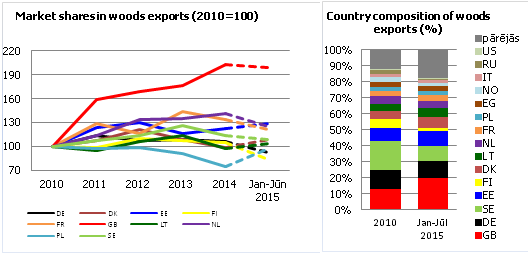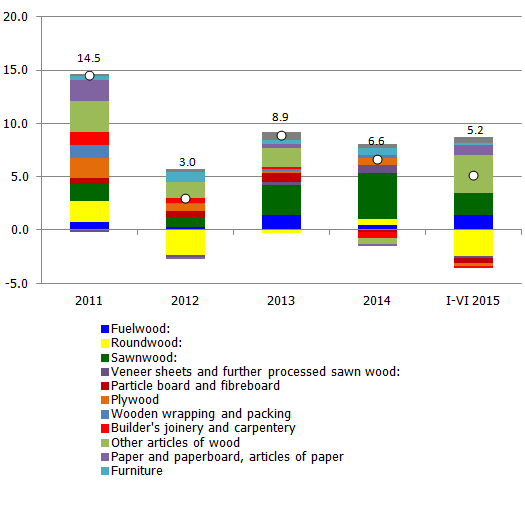Exports of wood: contribution to total exports and changes
For Latvijas Banka Monthly Newsletter, In Focus, October
Forests cover 52% of Latvia's territory and the forest industry has historically been one of the most important economic sectors in Latvia. Although the contribution of the forest industry to Latvia's economic growth and exports has changed significantly within the last fifty years, wood is still mentioned among Latvia's main export goods. Most of the forest industry output, about 75%, is exported. The contribution of articles of wood* to the overall national balance of exports reached a record-high at 43% in 1999 and 2000. Despite the fact that the exports of wood were increasing in the post-crisis period, the share of wood in Latvia's overall exports contracted to 17% in 2012. Nevertheless, in the most recent years the contribution of the forest industry to exports grew again and exports of articles of wood accounted for almost 21% of Latvia's total exports in the first half of 2015.
Chart 1. Market shares (2010=100) and country composition (%) of woods exports

Source: Eurostat, LB calculations; Source: CSB
Preprocessing output consisting of fuelwood, chips, roundwood and sawnwood accounts for the bulk of the forest industry exports. The contribution of preprocessed wood to exports has been contracting on an annual basis since 2000, with the share of further processed wood (pellets, briquettes, veneer sheets, boards, plywood, wooden wrapping and packing), furniture and artisan goods growing steadily.
Major export destinations for Latvia's wood products are the United Kingdom (in 2015, 19.6% of all exports of wood, except furniture), Germany (10.6%), Sweden (9.4%) and Estonia (6.3%). Within the last five years, the most significant growth of market shares for the exports of wood was reported in the case of the United Kingdom and Netherlands (see Chart 1). This year market shares have resumed growth even in those trade partner states where they were previously shrinking, i.e. in Poland, Lithuania, Denmark and Estonia. Market shares are expanding primarily on account of the exports of sawnwood, board, plywood, pellets and other articles of wood.
Despite the low activity in the construction sector of the EU member states, the export growth of the articles of wood remains positive. Before the crisis, woodworking industry was considered a low value added sector, whereas Latvia's wood exports of today have been experiencing quality changes for quite some time: the growth of the woodworking industry is primarily underpinned by expanding export opportunities, based on both, innovations and technology upgrades as well as resource efficiency and full life cycle of materials. An increasingly larger number of preprocessing companies continue with further processing and transform part of their outputs into higher added value articles. Woodworking was one of the primary drivers of manufacturing and exports in 2014 and the tendency continues this year as well. In the first half of 2015, the forest industry exports grew by 5.2% year-on-year. This year's export growth was supported by the increasing exports of fuelwood, sawnwood, other articles of wood, articles of paper, furniture and prefabricated buildings (see Chart 2). The shrinking export growth rate for the articles of wood can be explained by the weak external market activity.
Chart 2. Contributions of changes in forest industry outputs to annual growth rates (p.p.)

Source: Ministry of Agriculture, CSB, LB calculations
If we look at the prospects for the development of the forest industry exports, they seem promising. The so-far more or less steady growth of the forest industry exports, the stabilisation of the global prices on wood and the restart of lending growth in Europe suggests further recovery in the construction sector of the European countries. Considering that many European economies have announced national assistance programmes for the use of environment-friendly fuel and the growing public awareness of the environmental protection matters, the market for wood pellets and briquettes could also continue to expand.
Textual error
«… …»






